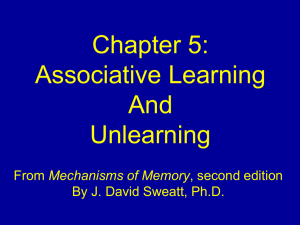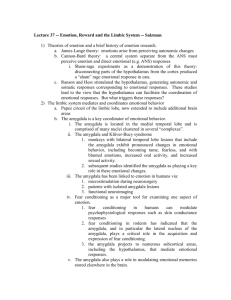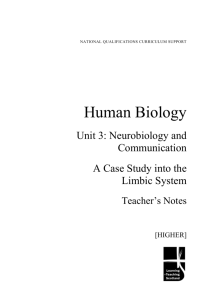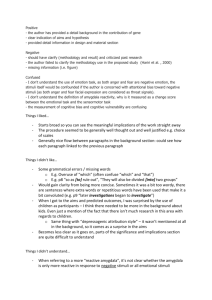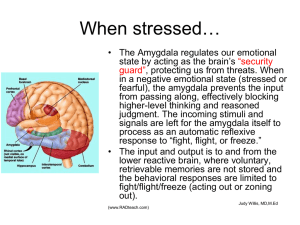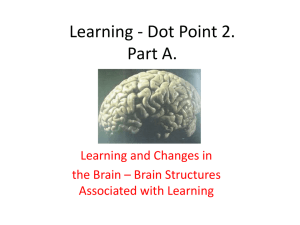Case Study on Limbic System
advertisement
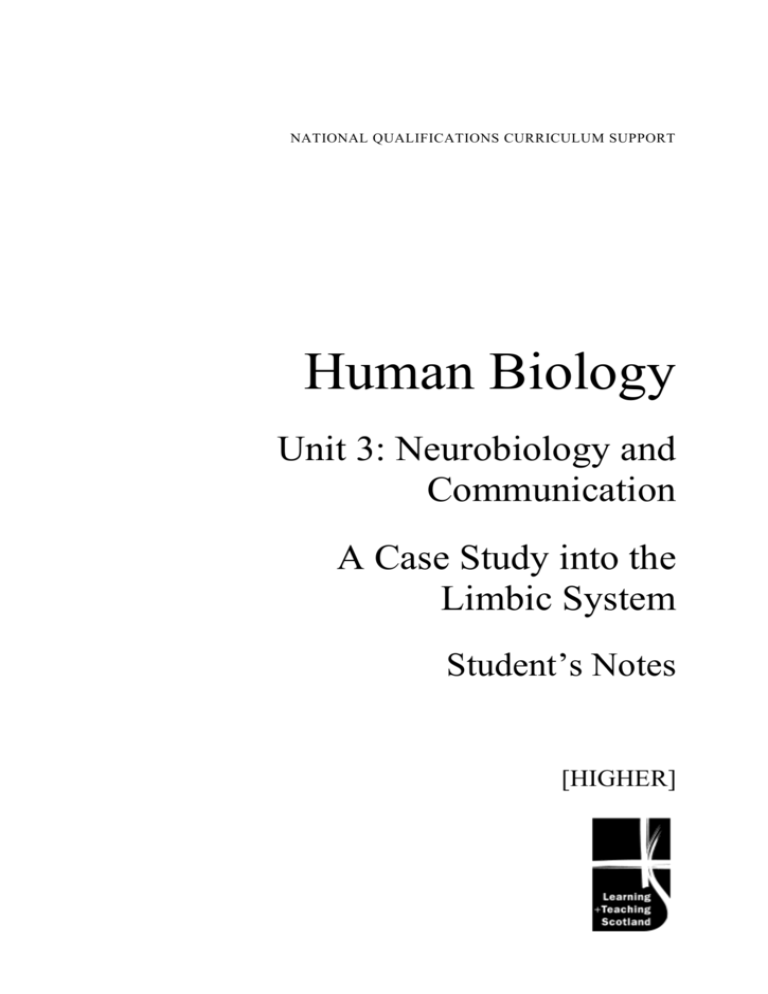
NATIONAL QUALIFICATIONS CURRICULUM SUPPORT Human Biology Unit 3: Neurobiology and Communication A Case Study into the Limbic System Student’s Notes [HIGHER] The Scottish Qualifications Authority regularly reviews the arrangements for National Qualifications. Users of all NQ support materials, whether published by Learning and Teaching Scotland or others, are reminded that it is their responsibility to check that the support materials correspond to the requirements of the current arrangements. Acknowledgement Learning and Teaching Scotland gratefully acknowledges this contribution to the National Qualifications support programme for Human Biology. The publisher gratefully acknowledges permission to use the following sources: Figure 1 brain connectivity graph from On the relationship between emotion and cognition by Luiz Pessoa from Nature, Vol 9 February 2008, p. 152, http://www.nature.com/nrn/journal/v9/n2/full/nrn2317.html, Reprinted by permission from Macmillan Publishers Ltd: Nature Reviews Neuroscience 9, 148-158 (February 2008) © 2008 http://www.nature.com/nrn/index.html; Diagram c freezing, from fear conditioning induces associate long term potentiation in the amygdala by Rogan Staubli and LeDoux from Nature, Vol 390, December 1997, p. 605, http://www.nature.com/nature/journal/v391/n6669/full/391818b0.html, Reprinted by permission from Macmillan Publishers Ltd: Nature 391, 818 (19 February 1998 © 1998 http://www.nature.com/nature/index.html; Diagram from http://www.dkimages.com/discover/previews/740/68987.jpg © Dorling Kindersley Every effort has been made to trace all the copyright holders but if any have been inadvertently overlooked, the publishers will be pleased to make the necessary arrangements at the first opportunity. © Learning and Teaching Scotland 2011 This resource may be reproduced in whole or in part for educational purposes by educational establishments in Scotland provided that no profit accrues at any stage. 2 A CASE STUDY INTO THE LIMBIC SYSTEM (H, HUMAN BIOLOGY) © Learning and Teaching Scotland 2011 Contents Background 4 Structure of the limbic system 4 Activity 1 6 Fear regulation and the amygdale 6 Connectivity of the amygdale 7 Activity 2 8 Circuitry of fear 9 Activity 3 10 An experimental paradigm for studying fear 11 Activity 4 12 A CASE STUDY INTO THE LIMBIC SYSTEM (H, HUMAN BIOLOGY) © Learning and Teaching Scotland 2011 3 STUDENT’S NOTES Student’s notes Background This case study aims to provide a deeper understanding of the limbic system using the regulation of fear as an example. The limbic system describes a set of inner brain struct ures that extend down through the core of the brain to the upper part of the brainstem. The functions of the limbic system include: emotional response learning and memory hormone regulation movement sensory perception. Structure of the limbic system The thalamus is a large collection of nuclei located on top of the brainstem near the centre of the brain. It relays sensory information to and from the cerebral cortex. The thalamus is also involved in motor signalling to the cerebellum and regulation of consciousness, sleep and alertness. Lying just below the thalamus is the hypothalamus, which links the nervous system with the endocrine system. It is a small structure with an important role in homeostatic control, body temperature regulation, hormone re lease, hunger, thirst and sexual behaviour. The hippocampus has the shape of a curved tube and plays an important role in memory and spatial navigation. Where the hippocampus ends, the amygdala begins. This cluster of nuclei is involved in emotional response and memory. Surrounding the amygdala and hippocampus is the parahippocampal gyrus. This portion of cortex helps to modify memory and emotional response. 4 A CASE STUDY INTO THE LIMBIC SYSTEM (H, HUMAN BIOLOGY) © Learning and Teaching Scotland 2011 STUDENT’S NOTES Another region of limbic cortex called the cingulate gyrus modifies behaviour such as aggression. It sweeps round over the fornix, extending towards the hippocampus. Just below the cingulated gyrus is the corpus callosum. It connects limbic structures on the right side of the brain with those on the left, and helps communication across the two hemispheres of the brain. The fornix is an arched pathway of nerve fibres transmitting information from the hippocampus and other limbic areas to the mamillary body. The septum pellucidum is a thin sheet separating the fornix from the corpus callosum. Located at the end of the fornix is the mamillary body. This small nucleus is important for relaying information to and from the fornix and thalamus. The olfactory bulb protrudes outwards from the limbic system towards the front of the brain and is concerned with the perception of odours. The inclusion of the olfactory bulb in the limbic system explains why our sense of smell can evoke a forgotten memory or an emotional response. A CASE STUDY INTO THE LIMBIC SYSTEM (H, HUMAN BIOLOGY) © Learning and Teaching Scotland 2011 5 STUDENT’S NOTES Activity 1 Using the information given above, label the diagram below t o show the structures of the limbic system. Figure from: DK Fear regulation and the amygdala Fear is a distressing emotional response brought about by the perception of threat. It is the ability to recognise aversive stimuli and respond accordingl y with strategies of escape and avoidance. Fear can range from mild caution to extreme phobia, and include emotional states such as worry, anxiety, embarrassment, horror, panic and dread. Some of the most common fears are of spiders, snakes, heights, e nclosed spaces, water, bridges and needles. 6 A CASE STUDY INTO THE LIMBIC SYSTEM (H, HUMAN BIOLOGY) © Learning and Teaching Scotland 2011 STUDENT’S NOTES The amygdala is essential for emotional memory and is a key structure in the neurobiology of fear. Extensive research has characterised the role of the amygdala in fear processing. Monkeys with lesions to the amygdala show reduced levels of aggression and fear together with increased tameness towards human handlers. Imaging studies in humans have also implicated the amygdala in fear whereby patients with damage to the amygdala cannot recognise the emotion of f ear when presented with pictures of frightened faces. Connectivity of the amygdala The graph below maps the connectivity of the amygdala in the brain. Brain connectivity graph of the amygdala Analysis of brain connectivity by Young and colleagues reveals that the amygdala (Amyg, centre of the graph) makes widespread projections all over the brain. In fact, it connects with all but eight cortical areas included in the analysis. Figure from: Pessoa, L. On the relationship between emotion and cognition. Nature Perspectives, 2008, volume 9. P152. The amygdala is a highly connected region of the brain. This makes sense given the complexity and importance of a fearful response. From initial sensory arousal to being able to remember an event months or even years later, fear involves multiple brain regions controlling autonomic and conscious behaviour. A CASE STUDY INTO THE LIMBIC SYSTEM (H, HUMAN BIOLOGY) © Learning and Teaching Scotland 2011 7 STUDENT’S NOTES The major brain regions connected to the amygdala and r esponsible for the overall processing and expression of fear are: hypothalamus thalamus hippocampus brainstem prefrontal cortex sensory cortex Activity 2 Imagine you are about to sit an exam. For each major brain region connected to the amygdala listed above, describe its role in the emotional response. Brain structures connected to the amygdala Hypothalamus Functional contribution to emotional response Thalamus Hippocampus Prefrontal cortex Sensory cortex Brain stem 8 A CASE STUDY INTO THE LIMBIC SYSTEM (H, HUMAN BIOLOGY) © Learning and Teaching Scotland 2011 STUDENT’S NOTES Circuitry of fear When the brain receives an emotional stimulus, such as something fearful, it is first detected by the thalamus. From there, two parallel pathways exist for processing this information: the thalamo-amygdala pathway (or the short route) the thalamo-cortico-amygdala pathway (or the long route). The short route provides a fast impression of the situation. No cognition is involved because the cortex is bypassed. This pathway activates the amygdala directly to generate an immediate emotional (eg fight or fl ight) response before any perceptual information is integrated into conscious experience. Information associated with the long route is processed by the cortex before reaching the amygdala indirectly to provide a full assessment of the fearful situation. Various sensory modalities of the perceived stimulus are processed by the primary sensory cortex, including visual and auditory cues, to build up an elaborate conscious representation of the fearful stimulus. The hippocampus is then recruited to support memory of the situation, in particular the context in which an aversive experience is associated with. This structure is required for learning about the danger of an object or situation and explains why we do not repeatedly touch a hot plate, for example. The amygdala itself is composed of several nuclei that have specific roles in processing fear. The lateral nucleus is the major input, receiving sensory information from the thalamus. The central nucleus is the major output of the amygdala, sending information to other brain structures responsible for the physical reactions associated with fear such as increased heart rate, perspiration, tense muscles, etc. A number of internal pathways have been identified by which information is routed from the lateral nucleus to the central nucleus. Neurons of the lateral nucleus project to intermediate nuclei, including the basal nucleus and the medial nucleus. These structures then relay information to the central nucleus. There is also a direct connection between t he lateral nucleus and the central nucleus. Each of these nuclei can be modulated by brain structures that can influence the emotional response such as the hippocampus, the cortex and the hypothalamus. A CASE STUDY INTO THE LIMBIC SYSTEM (H, HUMAN BIOLOGY) © Learning and Teaching Scotland 2011 9 STUDENT’S NOTES Activity 3 Using the information above, complete the flow diagram below, showing how an emotional response is regulated the by the amygdala and its connecting structures. Highlight the short and long routes for processing information. 10 A CASE STUDY INTO THE LIMBIC SYSTEM (H, HUMAN BIOLOGY) © Learning and Teaching Scotland 2011 STUDENT’S NOTES An experimental paradigm for studying fear Classic conditioning is a form of learning that involves presentation of a neutral stimulus with a biologically significant stimulus. The neutral stimulus is any action that does not result in a behavioural response and is called the conditioned stimulus (CS). The biological ly significant stimulus evokes an innate behavioural response and is called the unconditioned stimulus (US). If the CS and the US stimulus are repeatedly paired, eventually the two stimuli become associated and a behavioural response is evoked by the CS alone. This is called the conditioned response (CR). Classic conditioning was first demonstrated by Ivan Pavlov (it is also called Pavlovian conditioning) when he conditioned his laboratory dogs to salivate to the sound of a bell. He paired the presentati on of food (the UC – biological response) with a bell (CS – neutral response) and after a few repetitions the dogs began to salivate in response to the bell alone. Classic conditioning has provided a model behavioural paradigm for studying emotional learning. Fear conditioning is where an organism learns to predict an aversive event. During fear conditioning subjects rapidly acquire fear to a previously innocuous stimulus. In rodents, for example, a neutral tone (CS) can be paired with a mild electric shock (US) to generate a conditioned fearful response to the tone alone. Fear conditioning has been studied in numerous species and the neural mechanisms are highly conserved across species. In humans, fear conditioning is typically measured by monitor ing skin conductance responses. In rodents, conditioned fear is often measured by the freezing response – a length of time during which the animal is immobile and observing its surroundings for further fearful stimuli. A CASE STUDY INTO THE LIMBIC SYSTEM (H, HUMAN BIOLOGY) © Learning and Teaching Scotland 2011 11 STUDENT’S NOTES Activity 4 Study the diagram and information below and analyse the results for this experiment. Using this information, answer the questions to develop a method and conclusion for the experiment: What are the CS, US and CR? What is happening at each stage in the experiment (testing, tr aining and testing? Why is there a drop in the freezing response of the conditioned group between sessions 6 and 7? The conditioning chamber was constructed of stainless-steel bars and kept within a ventilated and temperature-regulated acoustic isolation box. Stimulus delivery and data collection were controlled by adjoining electrical accessories. The isolation box was equipped with a video camera for recording behaviour. Fear conditioning in the rat leads to associative conditioning of fear behaviour. Image from: Rogan, Staubli and LeDoux, Fear conditioning induces associative long-term potentiation of synaptic currents in vivo. Nature, 1997, volume 390, p605. 12 A CASE STUDY INTO THE LIMBIC SYSTEM (H, HUMAN BIOLOGY) © Learning and Teaching Scotland 2011

